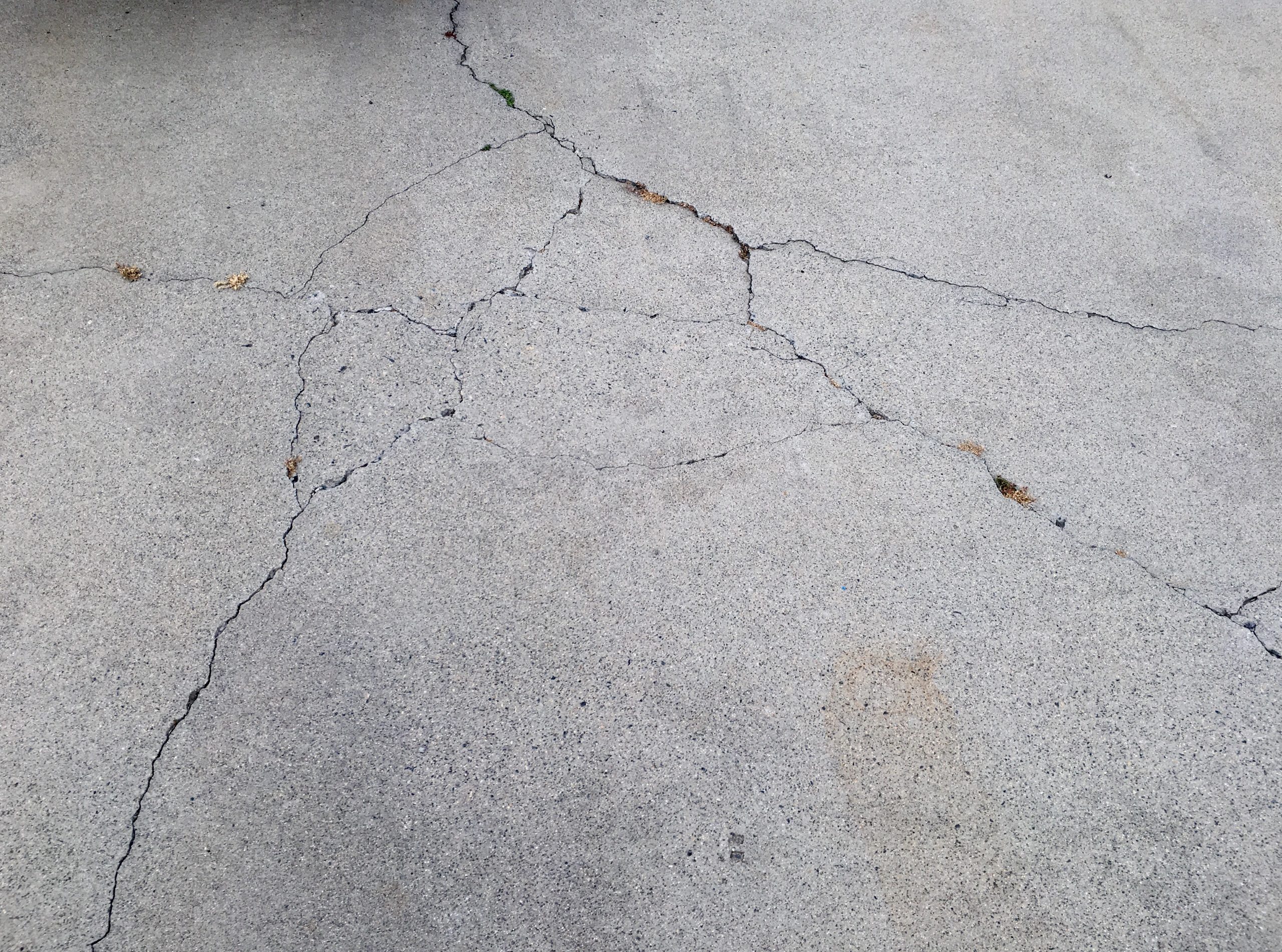Cracks in concrete flatwork — like driveways, patios, slabs, or stairs — are unsightly. But how do you know if they are a cause for concern?
When you see damage in your concrete, you should always evaluate if it’s getting worse over time. Preventative maintenance can help save your structure or flatwork before it’s too damaged and needs replacement.
Learn all about concrete cracks, what causes them, and how to fix them in this article.
Why Does Concrete Crack
Concrete can crack for a variety of reasons:
Temperature fluctuations cause concrete to expand and contract, which can lead to multiple types of cracking over time. Hot, dry temperatures like Austin, TX can cause concrete to dry faster than expected if precautions aren’t taken, which can also lead to cracking. In the winter, freezing and unfreezing can also cause areas to lift and crack.
Though concrete is a sturdy, strong material, excessive weight that’s over its load limit will cause cracking. In addition, heavy weight over time can cause deterioration of concrete structures.
Settling, such as when a foundation settles as the ground compresses underneath it, can lead to cracks due to uneven load bearing as the foundation becomes unlevel.
Types of Concrete Cracks
Common types of concrete cracks have specific names — this can help you identify what’s wrong with your concrete and find the right professional to fix it!
Re-entrant corner cracks happen when concrete is poured around an object, like a column. The corners or areas around the object may shrink unevenly while drying. Due to the cracks, this area then is subjected to higher stresses and cracks begin to radiate from the object.
Expansion cracks are formed when concrete expands due to temperature and has nowhere to go. The forces of the expansion cause cracks. To prevent this, a contractor can install expansion joists in your concrete to allow for fluctuation.
Heaving cracks are similar to expansion cracks but with a slightly more specific definition. The cycle of freezing and thawing in the winter can cause the ground to rapidly expand and contract, which results in a lifted, or “heaved” concrete, and thus, cracks and uneven areas.
Settlement cracks happen in foundations when the structure settles over time. This can be due to the ground compressing naturally, poor drainage that leads to pooling water, decomposing tree roots, or other reasons. The uneven settling causes the load to crack the concrete used in the foundation.
Shrinkage when concrete is drying is the most common type of crack, and luckily, the easiest to prevent. This occurs when the concrete hardens and water evaporates during the drying process. If the concrete dries too quickly or unevenly, the hardened areas experience and increase in tensile stress, which causes cracking. To prevent this, professionals will take precautions when pouring to control the cracking and shrinkage.
How to Prevent Concrete Cracking
Preventing concrete cracking is easier said than done. The best way to prevent cracks is to thoroughly prepare.
Choose your site wisely. Pouring over uneven ground, soil that doesn’t drain well or is subject to pooling water, or in areas with lots of plant roots. If the site is unsuitable, you’ll experience uneven settling, water intrusion, and other issues that will most definitely result in cracking over time.
Take care when pouring & curing. Pouring during a heatwave or a rainstorm might hurt how your concrete cures, thus leading to a higher likelihood of cracks in the future. If you must pour, erect a protective cover and take precautions to ensure your concrete is kept as cool and dry as possible.
Consider water content. For best results in certain scenarios, professionals recommend a stiffer concrete mixture with a low water content. This is more difficult to work with, but does have benefits of less shrinkage.
Use control joints. Control joints are intentional breaks or grooves set into the concrete that control where and how the concrete cracks. This prevents random cracks, as the patterns are pre-planned with structural integrity in mind.
Trust a professional. Concrete pouring might look like a simple DIY project, but there’s a lot of engineering and knowledge behind the best results. You can pour a patio or DIY a driveway, but for results that last, it’s best to trust a professional.
How to Repair Concrete Cracks
The good news is that cracking concrete can be repaired. Professionals will carefully clean and inspect the area. Then depending on the type of cracks and severity of damage, will stabilize the area and use different products to fill and seal the cracks.
For instance, a foundation with cracks may require a service called deep foamjection. This is when foam is injected into the ground underneath the foundation to shore up the ground. Then the foundation is stabilized, and the cracks can be repaired with caulk, epoxy, or grout.
In a driveway or patio, the cracks may just need to be carefully filled and sealed without significant prep work to stabilize the area.
Can I DIY this?
Cosmetic cracks can be DIY-ed, though for the best possible long-term fix, it is wise to consult a professional who can identify the type and cause of the cracking. You can patch up cracks in your patio, but over time, you may still encounter heaving if water consistently pools under your concrete!
Cracks in structural concrete should always be left to professionals to ensure the fix is safe and successful.
Concrete Repair in Austin, TX
Need concrete services in Austin, San Antonio, or other areas in Texas? Look no further — get in touch with Apex Concrete Repair for a customized solution. Book your free consultation now.
